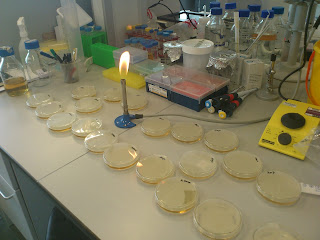Whilst much I'll be learning revolves around methods of obtaining and processing scientific data, almost certainly the most important skills I will be learning are that of deep critical analysis of our evidence, forming hypothesis based on past evidence and trying to deduce relationships from what we find. As the late Carl Sagan mused, ''science is a way of thinking, much more than it is a body of knowlege''.
 |
| 'I think'. The mark of great scientists past and present is the ability to follow the evidence wherever it leads, discard unsubstantiated notions, and to be open to enough to imagination, to allow for acceptance of new ideas. |
|
|
So! In this entry I'm going to pick my brain to highlight some of my thoughts to you guys and maybe propose a few hypothesis.
Recent research (
http://www.ncbi.nlm.nih.gov/pubmed/21726807) has implicated Nitric Oxide (NO) as an important physiological regulator of autophagy. It
downregulates the activity of autophagocytic machinery through a few key routes:
1) Prevents phosphorylation of Bcl-2 by JNK-1 (two key proteins). This leaves Bcl-2 activated. Bcl-2 proceeds to bind key autophagy initiation factor Beclin-1 and deactivate it, preventing autophagy initiation.
2) Upregulates mTorC1 which blocks autophagy through a variety of means.
3)Prevents binding of Vps34 with Beclin-1, preventing formation of the inititaion complex.
It mediates these effects (especialy effect #1) mainly through its ability to 'S-nitrosylate' a specific amino acid called
Cysteine located in the reactive site of many of these proteins.
 |
| Cysteine s-nitrosylation. the NO reacts with the thiol (HS) group on the cysteine replacing it with a nitrosyl group. |
|
The resulting nitrosyl group is much less reactive than the thiol group it replaced, resulting in a reducation of activity on the effected cysteine. It is s-nitrosylation at cysteine number 116 on JNK-1, prevents it's ability to phosporylate, and hence deactivate, Bcl-2.
Hydrogen Sulphide, the chemical I am investigating, has a very similar mode of action to NO! It 's-sulfhydrates' cysteine residues, and in an interesting point,
it massively increases the reactivity of the effected cysteine! (
http://www.ncbi.nlm.nih.gov/pubmed/19903941)
 |
| Cysteine s-sulfhydration. The hydrogen sulphide reacts with the thiol producing a highly reactive sulpfhydryl group. |
|
So this posses an obvious question. Does the increased reactivity of this important cysteine residue increase its ability to phosphorylate Bcl-2, and activate autophagy? And possibly work in other ways to activate the process, in an opposite fashion to nitric oxide?
An interesting hypothesis would be that Nitric Oxide and Hydrogen Sulphide work synergysticly to up and down regulate autphagy through interaction with cysteine residues.
We all know theres only one way to find out! . . .
And see what the evidence has to say! =)






.jpg)
















